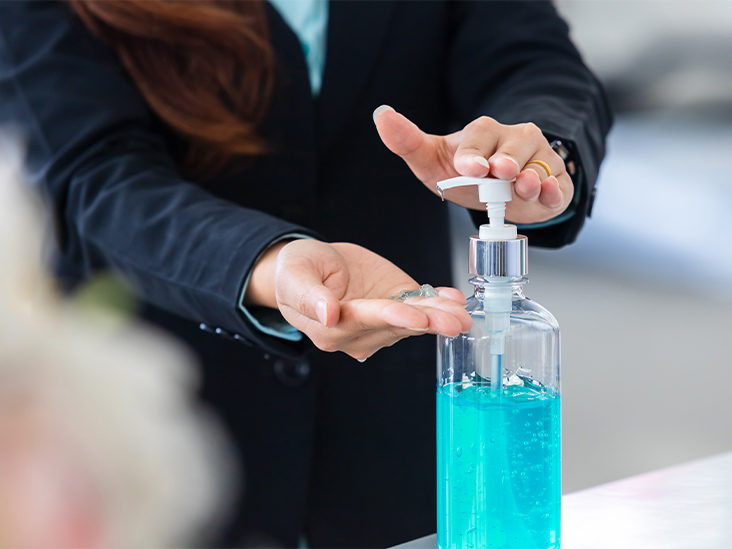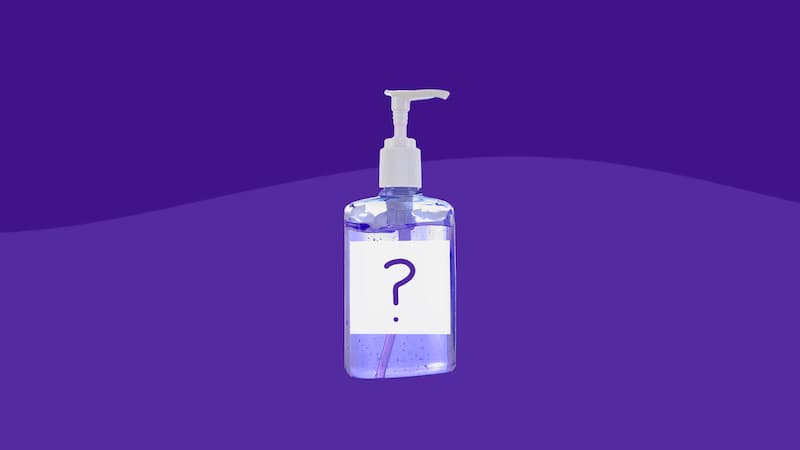First, what causes a sanitizer to not work well?
The presence of water, food, fatty materials, feces and blood on hands can significantly reduce the effectiveness of an alcohol-based hand sanitizer. In environments where food is served, viruses like the norovirus are a concern.
The main factor causing foodborne outbreaks is norovirus. The majority of hand sanitizers do not eradicate norovirus.
Please continue reading as I explain the specific information in the post.
Table of Contents
What Causes A Sanitizer To Not Work Well?
Sanitizers are not cleaners, and they cannot get rid of the dirt where bacteria and viruses are found.
Detergents and soaps are wonderful. Soaps reduce water’s viscosity and remove water tension, which enables the water to penetrate dirt and wash it away.
In reality, detergents surround oils and keep them apart (repel), allowing water to pass through and remove them.
both these activities also wash away the bugs which are stuck to the dirt and oils.
Yes, people, soaps and detergents only affect the water that you use to wash yourself; they have no effect on your skin. Simply moving dirt from one location—like your skin—to another—like the drain—is cleaning.
Sanitizers make no such adjustments. Bugs are simply poisoned with (typically) alcohol, which causes them to die. They make no effort to clean your skin. Only after washing your hands do sanitizers function effectively.
Sanitizers, however, can be useful in lowering the bacterial and viral load on your hands if your hands are generally clean.
Benefits Of Hand Sanitiser
Cleanliness
No one should be surprised by this. One of the main benefits of hand sanitizer is that it sanitizes. The purpose of it is to handle that and get rid of germs. When properly applied, hand sanitizers can remove 99.9% of the bacteria on your hands.
Portability
A sink is too heavy to always have with you. Sometimes, when you need to wash your hands, you won’t always have access to soap and water. A tiny bottle of hand sanitizer can be stored in your glove box, bag, or even pocket. It’s also ideal if you’ve just entered a game or emerged from a public space like a market.
Lowers The Risk Of Getting Sick
Your health depends on minimizing your contact with other people’s germs, especially when the flu season is in full swing. Throughout the day, take breaks to lower your risk of becoming ill. It is crucial to keep your hands as sanitized as you can because even a quick trip to a friend’s house or the store could expose you to germs that could cause the flu, a cold, or other illnesses.
How Do Hand Sanitizers Eliminate Bacteria?
You can find words like isopropanol, ethanol, or propanol on the ingredient label when you flip the hand sanitizer bottle over. Regular non-alcoholic hand sanitizers also include antibacterial ingredients like triclosan or benzalkonium chloride. These are the main components of hand sanitizer, which can get rid of those unpleasant germs.
Rubing alcohol and isopropanol are the same chemical. The primary ingredient in alcohol is ethanol, and propanol is an isopropanol cousin. In order to effectively kill bacteria, hand sanitizer must contain 60% to 95% alcohol. Bacteria cannot be killed by hand sanitizers with alcohol concentrations below 60%.
Dry skin may result from the hand sanitizer’s main ingredient, alcohol. As a result, substances like glycerin, propylene glycol, and isopropyl myristate are used as conditioning agents to stop dry skin. To create a pleasant scent and gel-like consistency, fragrance and polymers are added separately.
Bacterial cells, like other cells, have a cell membrane covering all organelles. Between the internal and external environments of the bacteria, this membrane serves as a barrier. Bacterial death can be triggered by any damage to the cell membrane. This is how hand sanitizer functions. The bacterial cell’s cell membrane is first cut and dissolved, and after that, the protein is denatured.
Phospholipids make up the majority of bacteria’s cell membrane. Among lipids, phospholipids are one. One end contains two hydrophobic fatty acids called “tails”, and the other end is a “head” containing a hydrophilic phosphate group. The molecules of glycerol link these two components together.
Your hand sanitizer’s ethanol molecules will bind to the cell membrane as soon as they come into contact with it and start dissolving the lipophilic tail. In this manner, the cell membrane loses its structural integrity, bursts into numerous pieces, and leaks out of the “guts” of the cell. Because the hand sanitizer will denature cellular proteins after the organelles ooze out, this will kill bacteria on its own.
The secret to life is protein. The life of organisms will end if protein molecules are destroyed. Protein molecules are broken down during denaturation when pressure is applied from the outside. These outside forces can take the form of radiation, heat, or substances like potent acids or bases, concentrated inorganic salts, or organic solvents. Organic solvents include isopropanol, ethanol, and propanol.
An important factor in determining whether a molecule can carry out its function normally is the protein’s structure. Any alteration to protein structures will make them useless and eventually cause cell death.
By interfering with the hydrogen bonds in the secondary and tertiary protein structures, hand sanitizer denatures proteins. While side chains form hydrogen bonds in the tertiary structure, amide groups form hydrogen bonds in the secondary structure. The hydrogen bonds between the side chains of the tertiary structure are destroyed by ethanol, which causes the protein molecules to unfold.
Alcohol molecules start to flood in and break these hydrogen bonds after damaging the cell membrane. The protein molecule’s structure and its ability to perform its function will be destroyed once a new bond between the protein and the alcohol is formed. It has been established that bacterial cells would cease to function and die very quickly if these proteins were not functioning. See more about What Is A Patient Safety Attendant?
Are Sanitizers 100% Safe?
Since early childhood, we have been instructed to properly wash our hands with soap and water to prevent illness. Now that we are all adults, hand sanitizers have taken the place of the good old soap and water as a common hygiene choice among children today. A few drops of the liquid should be placed on your palm, and after thorough rubbing, you are done. Just that simple, but what about safety? Have you ever questioned whether using hand sanitizer every time is actually safe?
Know Your Hand Sanitizers
Your decision among the various hand sanitizers available on the market is very important. You will be stunned to know that not all hand sanitizers are the same. Only hand sanitizers with at least 60% alcohol should be used, according to the Centers for Disease Control and Prevention. Sanitizers made without alcohol are not only less effective at eradicating germs—they may even be harmful to your health. Such sanitizers may even cause the bacteria to become resistant to them.
Additionally, try to stay away from sanitizers that include triclosan, a synthetic additive used in antibacterial products. It has been reported that a high dose of triclosan exposure can cause some thyroid hormones to decrease, which makes bacteria resistant to antibiotics.
How Effective Is Your Hand Sanitizer
Depending on how you use it, the effectiveness may vary. Put a small amount of hand sanitizer on your palm, rub it over the surface of your hands to remove bacteria and germs, and then wait for it to dry. After applying it, don’t wash your hands or wipe them. An alcohol-based sanitizer can effectively eliminate 99.9% of bacteria, fungi, and viruses when used as directed.

Are Hand Sanitizers Actually Useful For Treating Covid?
Hands are a common way for infectious diseases to spread. They include:
digestive disorders; respiratory infections like the common cold, influenza, and COVID-19. Salmonellosis.
Hands are the primary method of transmission for 80% of common infections.
So, limiting the spread of COVID-19 will undoubtedly be made easier by keeping hands clean and sanitized. One method to keep hands clean and hygienic is to wash them frequently with soap and water.
While moving around, we are unable to find a hand washing facility. In this situation, hand sanitizers are very helpful. By immediately sanitizing our hands with a good hand sanitizer after touching anything or shaking hands with someone who has an infectious agent on them (like the COVID-19 virus), we can keep both ourselves and those who come into contact with us safe.
Other sanitizers besides hand sanitizers include surface sanitizers, sanitizing wet wipes, and air sanitizers. Utilizing them will aid in keeping the COVID-19 under control.
What Servsafe Quizlet Causes A Sanitizer To Not Function Effectively?
What stops a sanitizer from working properly? Items are removed immediately. Which requires cleaning and rinsing but not sanitizing? A client requests a ham sandwich on whole wheat bread with lettuce, tomatoes, and mustard.
What Poses The Biggest Risk To Food Safety?
What poses the biggest risk to the safety of food? Bacteria pose the biggest risk to food safety of any type of microorganism. Bacteria are single-celled, living creatures that expand quickly in a favorable environment.
When Food Is Kept At Supportive Temperatures For Too Long
Because leaving food out at room temperature for too long can encourage the growth of dangerous bacteria that can lead to illness, including Staphylococcus aureus, Salmonella Enteritidis, Escherichia coli O157:H7, and Campylobacter. In nature, there are bacteria everywhere. They exist in our food, water, air, and soil.
Appropriate Time For A Food Handler To Use Hand Antiseptic
Only after performing a thorough hand wash should hand antiseptics be applied. The single most efficient way to stop the spread of bacteria and viruses, which are the main causes of foodborne illness, is to wash your hands with soap and water. On clean hands, hand antiseptics effectively eliminate some viruses and bacteria.
Steps For Proper Handwashing & Hand Sanitizing
- Use the designated hand sink to wash your hands. Apply warm water to your hands. Apply soap, lather, scrub, and use a nail brush for 20 seconds. Rinse. Dry hands with paper towel. the towel to turn the faucet off.
- Choose a hand sanitizer that has at least 60% alcohol in it.
- On the palm of one hand, dab a dime-sized amount of hand sanitizer.
- Spend 30 seconds vigorously massaging both hands together, making sure to cover the entire surface area. If hands are dry in just 10 to 15 seconds, there wasn’t enough sanitizer used, and more needs to be used.
- Before touching surfaces that will come in contact with food, let the sanitizer completely dry.
The Bottom Line
The pathogens that food workers have on their hands can be eliminated most successfully by washing with soap and water. Hands must first be washed with soap, rinsed with running water, and completely dried in order for hand sanitizers to function as intended. In food service establishments, handwashing with soap and water is required by the Minnesota Food Code.
Feel free to post a comment if you have any queries.
I want to thank you for reading, but that’s not the end of it.

